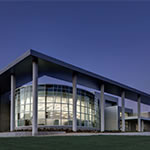Back in 2008, Texas’s Irving Independent School District made an unprecedented move by green-lighting Lady Bird Johnson Middle School. If the project was successful, the 152,000-square-foot school would break new ground in the world of green building, becoming the first net-zero middle school in the state of Texas, as well as the first and largest net-zero middle school in the United States. It made it. Lady Bird opened its doors in fall 2011 and earned every distinction.
A lot has changed in three years. What originally made Lady Bird so unique is becoming more commonplace, especially in the South. In 2012, for example, Kentucky’s Warren County Richardsville Elementary School became the first net-zero public elementary school in the country. As net-zero schools proliferate, revisiting those early adopters can provide valuable insight for project teams just now reaching for net zero.

Beneath this football field is a geothermal system that naturally conditions the building. Lady Bird is the first school in its district to use a geothermal system.
PUSHING THE ENVELOPE
Lady Bird Johnson Middle School is holding up well. Don Penn is a geothermal engineer with Image Engineering Group, which handled Lady Bird’s mechanical, electrical, and plumbing (MEP) engineering. When planning for the school began in 2008, Penn says the biggest challenge was being in uncharted territory. Never before had his company combined so many different renewable-energy and sustainable-building systems—including geothermal water-source heat pumps, greywater-reuse systems, 2,988 solar photovoltaic panels, and an academic curriculum based on all of it. With the help of Bosch, a global appliance manufacturer that has grown to provide a variety of sustainable solutions in recent years, the team also incorporated wind turbines, LED lighting, and high-efficiency glazing.
“We were familiar with all of the technology, but we’d never before had the chance to bring it all together in one place,” Penn says. “The school is holding up great, and it continues to be a bright spot for us. This was our chance to push the envelope on sustainability, and Lady Bird Johnson will always be a project we’re very proud of.”

Photovoltaic panels cover Lady Bird’s white roof and provide 100% of the school’s energy over the course of a year. The Solyndra panels feature cylindrical tubes that capture sunlight from 360 degrees.
PART OF THE CURRICULUM
Corgan Associates, the architecture firm that designed the middle school, had an entirely different set of challenges to navigate in order to ensure the school continued operating at net zero after completion. Susan Smith, a vice president at Corgan Associates, says the site was the biggest hurdle. Much of the surrounding land was developed, leaving them with one long, skinny plot to work with, oriented north-south. They conducted lighting and shading studies in order to optimize the available sunlight.
“A green school isn’t the same as a net-zero school,” Smith says. “This was an aggressive goal at the time because a net-zero school of this size had never been done, and it was our first net-zero project. It was a lot to tackle but well worth it.”
Designing the school was difficult enough, but making sure it would be used efficiently was tougher yet. Teachers and other school officials had to commit to sustainability. “The building user must use the building efficiently in order to capture the operational cost efficiencies of the sustainable systems,” Smith says.
This is especially true when considering that the school itself is part of the curriculum. All of the data collected on energy savings and expenditures is used as part of math and science classes, and older students learn about sustainability by way of the green design elements and technology featured on campus.
STUDENT AMBASSADORS
Lady Bird principal Carrie Daniels says the school was a way to put the city, Irving, on the map. But something even more meaningful has emerged in the three years since the school was completed: the understanding that the school elicits tremendous pride in its young students.

A kiosk educates students about wind energy. All of the data collected on energy savings and expenditures is used as part of math and science classes.
“We had no reason to believe the school wouldn’t hold up beautifully, but what we didn’t anticipate was how well it would go over with students,” Daniels says. “We have students who volunteer to be student ambassadors and run various green areas of the school. They also give tours. They love having a unique school, and it’s caused an awareness of sustainability and of their carbon footprint that I don’t know if they would have developed otherwise.”
Daniels’s own child, who also attends Lady Bird, brought home that mentality—literally. At home, the two have talked excitedly about the school’s many “cool” features.
“In my opinion, the real beauty of what’s happening goes beyond net zero, beyond the technology,” Daniels says. “Our kids are spreading knowledge to their homes and their communities. That’s the real takeaway here. The world is changing, and we need to change right along with it. What our kids are getting here is invaluable. It’s not just a lesson in a classroom—sustainability is now what they’re living. Their passion opens up a dialogue, one that leaves the school and inspires action that can help change the world.”

